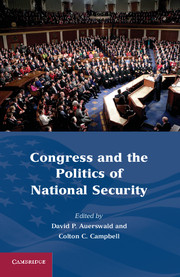Book contents
- Frontmatter
- Contents
- Figures and Tables
- Contributors
- Part One Historical and Institutional Challenges
- 1 Congress and National Security
- 2 Congress and U.S. Foreign Policy before 9/11
- 3 Institutional Challenges Confronting Congress after 9/11: Partisan Polarization and Effective Oversight
- Part Two Oversight Challenges
- Part Three Policy Challenges: Contours of Debate
- Works Cited
- Index
- References
2 - Congress and U.S. Foreign Policy before 9/11
from Part One - Historical and Institutional Challenges
Published online by Cambridge University Press: 05 June 2012
- Frontmatter
- Contents
- Figures and Tables
- Contributors
- Part One Historical and Institutional Challenges
- 1 Congress and National Security
- 2 Congress and U.S. Foreign Policy before 9/11
- 3 Institutional Challenges Confronting Congress after 9/11: Partisan Polarization and Effective Oversight
- Part Two Oversight Challenges
- Part Three Policy Challenges: Contours of Debate
- Works Cited
- Index
- References
Summary
Paul Kennedy has written of the need to “reconcile the ‘structuralist’ and the ‘individualist’ approaches to understanding the making of foreign policy.” National ideology, he argued, results “from the fusion of two elements: the individual perceptions and insights of thinkers about the nature of politics and the institutional means by which those perceptions are transmitted to a wider audience” (Kennedy 1982, 144, 148). This admonition especially assists in explaining U.S. foreign policy, since the structure of the U.S. government has exercised an unusually significant role on the U.S. response to world affairs. Given a constitutional structure that features a complex intersection of executive with various types of legislative powers, understanding the U.S. position in international affairs requires including the congressional perspective.
Before the post–Cold War period, the congressional role in U.S. foreign policy divided into four distinct eras. The first extended from the Constitutional Convention through the 1820s and featured a series of precedents translating the Constitution’s often vague clauses into the actual making of foreign policy. The second lasted for the remainder of the 19th century, with a generally dominant Congress debating and (at least after the 1840s) ultimately rejecting territorial expansion – all while staving off challenges from presidents such as James Polk and James Buchanan who sought greater executive freedom of action. The period from 1899 through World War II was characterized by a series of battles between Congress and the executive over the two primary foreign policy powers shared between the two branches – war making and treaty making. Those two congressional functions became less important during the Cold War, but ambitious members of Congress found other ways – procedure, power of the purse, oversight – to influence foreign affairs.
- Type
- Chapter
- Information
- Congress and the Politics of National Security , pp. 18 - 44Publisher: Cambridge University PressPrint publication year: 2011



